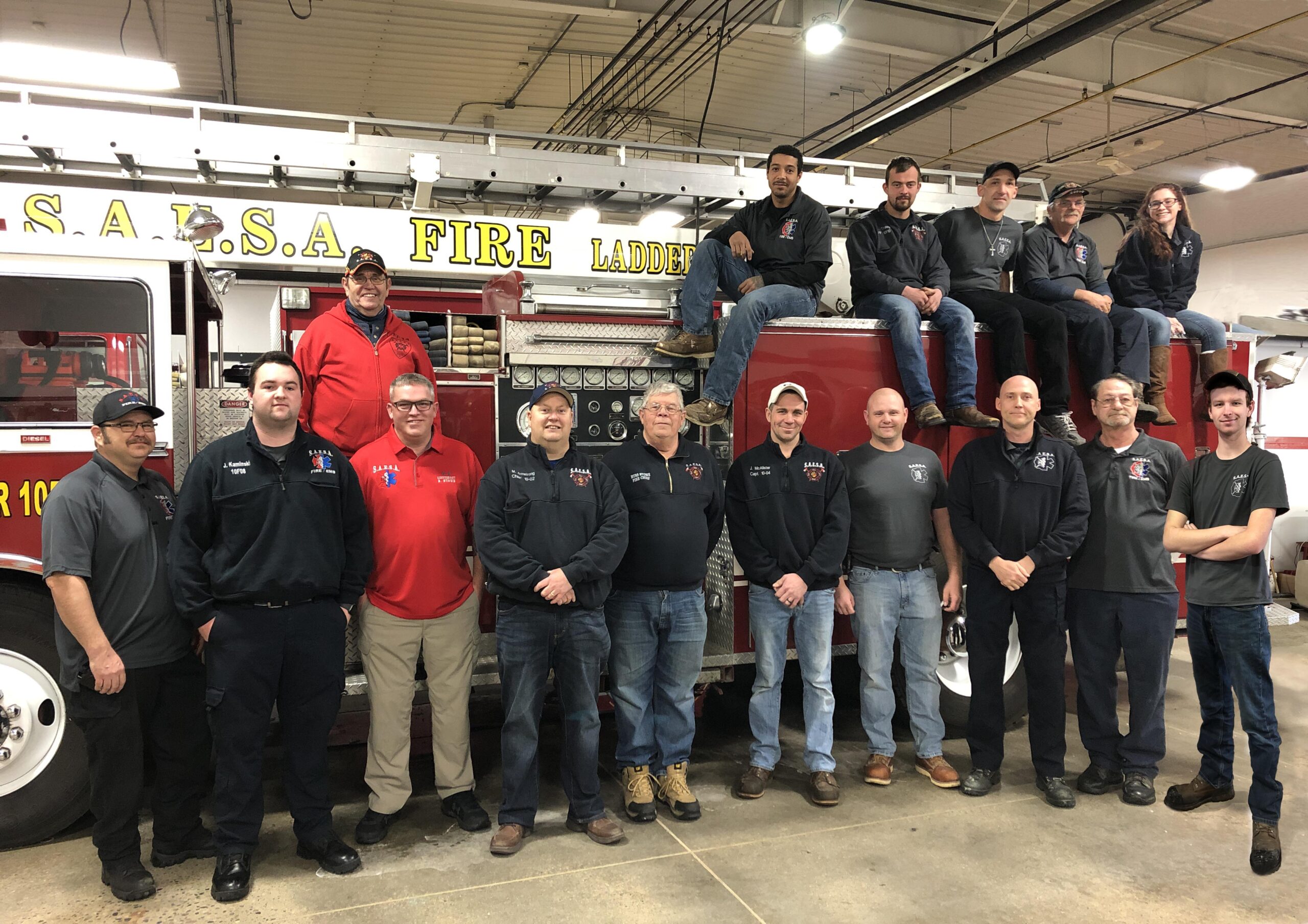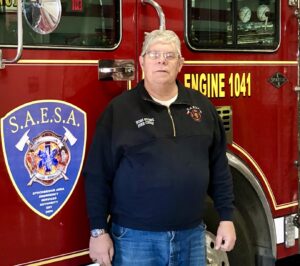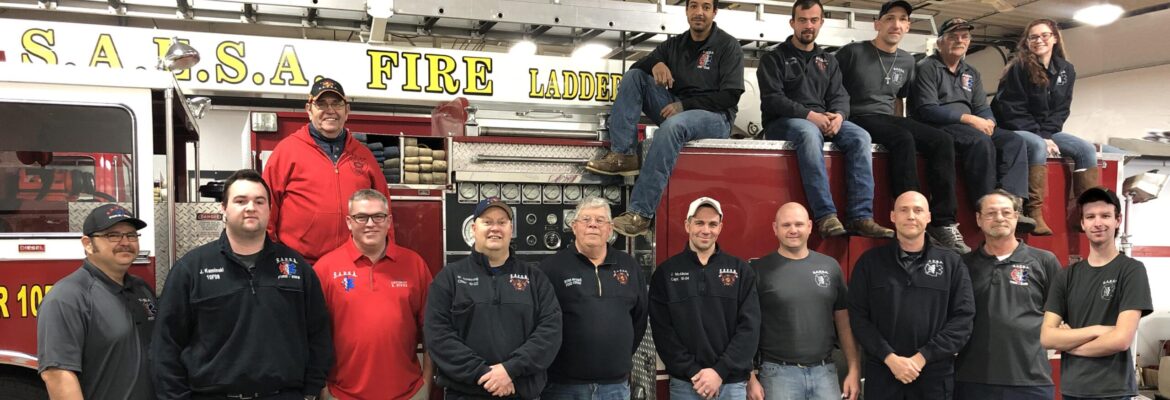To SAESA’s firefighters, it’s all about helping community (SAESA, Part 1)

SAESA Firefighters stand ready to serve. Front row: Jeremy Muraf, Jared Kaminski, Brent Stowe (lieutenant), Mark Armstrong (assistant chief), Russ Stowe (chief), Josh McAlister (captain), Tim Moore, Erik Youngblood, Jeff Long (engineer), Levi Zeitz. Back row: Douglas Sommer, Neko Robinson, David Tracy, Ryan Whited, Randy Griffith, Irene Wagar. Not pictured: Matt Harden, Dan Hamel, Jacob Hudson, Rich McDonald, Ryan Risner, Dillon Williams, and Kael Youngblood. Photo credit: Patrice Johnson
by Patrice Johnson
We all have paused at times to listen to the wail of a fire siren. We’ve seen the footage of New York firefighters rushing up a Twin Tower stairwell against the downward crush of humanity. Ask a firefighter why he or she charges into crisis situations and answers will vary, but two words are bound to surface: “to help.” This desire to assist others seems to run through first responders’ DNA, and the firefighters of the Stockbridge Area Emergency Services Authority serve as prime examples.
Russell Stowe, SAESA’s fire chief, summarized his motivations this way. “I want to help the community. I like to be involved.”
After 45 years with the Stockbridge Fire Department, last August’s inferno at Lakewood Apartments on South Clinton Street in downtown Stockbridge remains fresh in Stowe’s mind. “It was an eye opener,” he said as his facial expression darkened. “Let’s face it. You don’t know what you’re walking into. Your adrenalin is pumping. You’re lining up resources as you respond, and the first thing you want to know is ‘Where are all these people that live here?’”
Stowe’s lopsided grin revealed a fondness for—and knowledge of—the local community. “Most of the people who lived there knew everybody else who lived there,” he said. “They could point out where another resident was standing or knew that someone had gone to visit a grandmother.”
ORGANIZING FOR EFFECTIVENESS. Currently, SAESA’s 26 firefighters and 16 medical first responders are on call around the clock to serve Stockbridge, Bunker Hill, Waterloo, and White Oak townships. Two pumper trucks, a tanker, a ladder truck, a rescue rig, and three brush trucks stand ready to assist in responding to structure fires, field fires, automobile accidents, and hazardous material incidents. SAESA’s ambulance services (to be covered in Part II of this two-part series next month) operate with 16 emergency medical personnel and 3 ambulances.
SAESA also participates in a mutual-aid agreement with neighboring emergency authorities through a centralized dispatch system. John Beck, SAESA’s general manager, explained, “If anything big pops off at Henrietta, Unadilla—even Dansville, Leslie, or any of the surrounding areas—we’re going to get called in. It’s set up in a dispatch system. You might see emergency volunteers from all of those areas.”
Originally, the Stockbridge Township Fire Department and Stockbridge Ambulance, Inc. operated as separate and distinct organizations. In 2006, to better serve residents of its four-township area, SAESA was formed as a single government entity with millage funding of its own. Since then, Stockbridge’s ambulance and fire departments operate under one umbrella.
Beck, who devotes his time primarily to the ambulance side, said overcoming the us vs. them mentality was “the biggest bridge to cross.” Considering the close alignment between the departments, though, the realignment made sense, he said. “If a structure fire call comes in, the ambulance is going to go too,” Beck said. “They’re going to sit on the scene to be sure the firefighters’ vitals all stay within a range.”
SAESA doesn’t require volunteers to cross train with EMS, Beck added. “But we do encourage it in order to be more efficient.” Currently, seven SAESA volunteers are certified to administer both fire and emergency medical services:
| EMS | Fire Dept. | Total |
| 16* | 26* | 42 |
*includes 7 EMS and Fire personnel who are certified in both
Firefighter and EMS volunteers are compensated per hour on a call-by-call basis. Paid staff officers include Beck, Stowe, and three others: Mark Armstrong, assistant fire chief; Josh McAlister, captain; and recently promoted Brent Stow, lieutenant.
Beck and Russ Stowe both stressed that the volunteers are willing to pitch in and help each other as needed, whether the task at hand involves stretching hose lines or running an engine.

Fire Chief Russell Stowe notes, “If you’re dressed in a T-shirt that identifies you’re in the fire service, it doesn’t matter where you’re at—you can be Up North or in the next state over—and somebody is going to come up to me and say, ‘We really appreciate what you’ve done.’ We get that on both sides, on the EMS and on the fire side.” Photo credit Patrice Johnson
CHANGING WITH THE TIMES. Stowe has noticed significant changes over the years, not the least of which is a shift in public behavior. After Sept. 11, 2001, “If you’re dressed in a T-shirt that identifies you’re in the fire service, it doesn’t matter where you’re at—you can be Up North or in the next state over—and somebody is going to come up to me and say, ‘We really appreciate what you’ve done.’ We get that on both sides, on the EMS and on the fire side.”
Unlike Unadilla Township’s Fire Department with its four women volunteers, including its fire chief, SAESA has only recently added the first woman to its ranks—Irene Wagar, a firefighter.
“Irene is green. She’s just getting trained.” Stowe grinned like a proud parent. “To be a firefighter, you have to be state certified.” He said he was pleased to see Wagar expressing interest in EMS training as well as firefighting.
Wagar’s late arrival for the group photo for this article prompted gentle ribbing from a couple of her peers. In response, Wagar broke into a winning smile and gave as good as she got. “Hey, I had to get my kids in bed,” she said as she climbed up top of the 55-foot-long ladder truck to sit next to four other firemen.
Wagar and new recruits, Levi Zeitz, Ryan Risner, Ryan Whited, Jacob Hudson, Neko Robinson, and Kael Youngblood will need to complete their training and earn Michigan certification before they “can be put in harm’s way,” Stowe cautioned. “But they can still clean up. They can go chase parts and help with the truck.”
ASSESSING AND ADAPTING. Returning to the topic of the Lakewood fire, Beck recalled arriving at the scene and feeling concerned that, with the amount of water they were burning through, the firefighters could drain the water tower. “But Russ’s thinking was spot on,” he said in praise of Stowe’s making the call to request additional water tankers. “Russ was thinking along the lines of, ‘All right, if we can’t tag a hydrant, what are we going to do?’”
Stowe chimed in, his voice matter-of-fact. “We didn’t know how much water we were going to get out of the hydrant system for the square footage we had involved.”
“Nine tanker trucks lined up, and we were off to the races.” Beck nodded. “That was very impressive to watch unfold.”
As it turned out, the Village of Stockbridge’s hydrant system proved up to the task. Though the 16-unit Lakewood building was declared a total loss, another 16-unit apartment building in the complex survived intact. Lakewood apartments, along with the Clinton West complex, located on South Clinton St., are managed by the PK Housing & Management Companies out of Okemos.
“Ingham County has what is called the Tanker Task Force,” Stowe explained. “All the departments in Ingham County supply a tanker that can get paged out anywhere in the county. That’s quite an asset.”
“You could have up to 30,000 gallons of water sitting on scene,” Beck added. “As they dump one truckload, they go get more water, so you get a circle going and a constant flow of water.”
Stowe recollected a training scenario back when the Tanker Task Force first formed. After the city of Lansing suffered a major fire, they lost power, which rendered the city’s electricity-dependent pumps incapable of supplying water. The next training session presented the challenge of securing water without the use of hydrants.
As the firefighters conferred, Stowe suggested they back their tanker truck down to the Red Cedar River, drop in a hose, and draw water.
“What?” the city firefighters that asked, dumbfounded. “Do you mean pump water out of that river?”
“Yeah, if you want water,” Stowe replied nonchalantly.
Then, as now, SAESA and other rural departments were well adapted to fighting fires without hydrants. “It was kind of fun to watch,” Stowe chuckled, and was quick to add that he wasn’t faulting the urban firefighters. “They hadn’t been trained. But that’s what we do here. We know how to do it.”
Beck nodded. “I can’t stress how nice it is to have hydrants, but it is also very refreshing to know that, even though I live out where there is no hydrant, I have a pond in my front yard. If my house is on fire, I am quite certain they are going to draft water right out of that pond.” In the event of an emergency, Beck explained that State law allows for SAESA to acquire water from any source necessary, including rivers, creeks, ponds, and even swimming pools.
SUBSCRIBING SAVES. As emergencies arise and SAESA ambulance or fire services are called to the scene, area residents and family members bear no additional costs beyond their annual, $35 household subscription fee ($30 for senior citizens). Residents will be asked to provide insurance information, and SAESA will bill the insurance provider for the balance of payment, whether it’s home and property or medical insurance. Subscription forms are downloadable at SAESA.org.
VOLUNTEERING IS EASY. Those interested in becoming a volunteer firefighter need only pick up an application and fill it out to begin the process. SAESA will pay for firefighter training, gear, and ongoing education. In exchange, the authority asks new recruits to commit to one year of SAESA service.
In 2018, SAESA purchased the former automobile dealership at 1009 S. Clinton Street at the intersection Michigan-52 in Stockbridge. After undergoing $300,000 in renovations, the spacious, well adapted facility houses both the ambulance and firefighting departments. More information is available online at SAESA.org.
CUTTING TO THE BOTTOM LINE. When it comes to SAESA’s culture, one takeaway seems clear: The drive to help the community and support one another runs deep. A camaraderie binds SAESA personnel, much like brothers-and-sister-in-arms.
Next month, look for Part II on SAESA’s ambulance services.
| If a fire starts:
· Know how to safely operate a fire extinguisher · Remember to GET OUT, STAY OUT, and CALL 9-1-1 or your local emergency phone number. · Yell “Fire!” several times and go outside right away. If you live in a building with elevators, use the stairs. Leave all your things where they are and save yourself. · If closed doors or handles are warm or smoke blocks your primary escape route, use your second way out. Never open doors that are warm to the touch. · If you must escape through smoke, get low and go under the smoke to your exit. Close doors behind you. · If smoke, heat, or flames block your exit routes, stay in the room with doors closed. Place a wet towel under the door and call the fire department or 9-1-1. Open a window and wave a brightly colored cloth or flashlight to signal for help. · Once you are outside, go to your meeting place and then send one person to call the fire department. If you cannot get to your meeting place, follow your family emergency communication plan. Source: American Red Cross |
| If your clothes catch on fire:
1. Stop what you’re doing. 2. Drop to the ground and cover your face if you can. 3. Roll over and over or back and forth until the flames go out. Running will only make the fire burn faster. Source: American Red Cross
|


